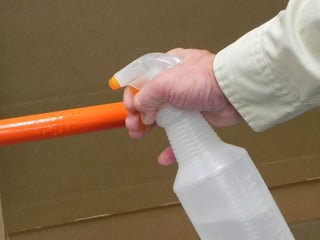Each hot line tool should be wiped clean and visually inspected for defects before use each day. If any defect or contamination that could adversely affect the insulating qualities or mechanical integrity of the tool is present after wiping, the tool shall be removed from service and examined and tested in a manner prescribed by OSHA before being returned to service.
CONDITION
It has been long recommended that CHANCE® hot line tools be wiped with a silicone-impregnated cloth prior to daily use. Combined with the required inspection, these are common-sense safety measures which have been a standard practice of many utilities.
PERIODIC MAINTENANCE AND TESTING
Per OSHA, every two years, hot line tools used for primary employee protection shall be removed from service for examination, cleaning, repair and testing. Also, anytime the daily wiping and inspection routine requires a tool to be removed from service, it must undergo the same examination, cleaning, repair and testing procedure that is required on a two-year basis for all hot-line tools.
All fiberglass-reinforced product (FRP) tools must be electrically tested unless repair or refinishing has not been performed, and the employer can demonstrate that the tool has no defects that could cause it to fail in use.
When testing of tools is required under any of the circumstances listed above, the specific methods are described in the OSHA Rules and Regulations and in IEEE Standard 516.
TEST METHODS
FRP tools require a wet test at 75,000 Volts per foot for one minute. Tests must verify the tool’s integrity along its entire working length.
An alternate Watts-loss test method that is performed at lower voltage (2,500 Volts minimum) is also acceptable. Either of these test methodologies require laboratory equipment and techniques.
Note that wet tests are never performed on wood tools. This is consistent with the long-held practice that wood tools should never be intentionally exposed to water under any circumstances.
“Other tests that the employer can demonstrate are equivalent” are also allowed by the OSHA Rules and Regulations. The following section describes tests at Hubbell Power Systems, Inc. to qualify one such alternate test as equivalent. This method also can be used to provide an enhanced verification of the tool’s integrity in the daily use routine. It is a proven and practical field test that does not require laboratory equipment or techniques.
OSHA Regulations and the CHANCE Hot Stick Tester
In response to the new OSHA regulations, CHANCE performed an extensive test series. Tests on new and used hot sticks compared the results using IEEE tests prescribed in the OSHA Regulations and the CHANCE Portable Hot Stick Tester. Wet tests were of particular interest because of the OSHA wet test requirements. The purpose was to determine the appropriate uses of the CHANCE hot stick tester. Other objectives were to obtain a comparison between wet and dry tests and to determine the effectiveness of wax versus silicone oil. In 1995, CHANCE introduced a redesigned wet/dry hot stick tester to test to the new standards [Cat. No. C4033178 (110 VAC) and Cat. No. C4033179 (230 VAC)].
CONCLUSIONS
A hot stick must have either internal conductivity or a contaminated surface to fail a dry test. None of the test sticks ever failed a dry test, even though the used sticks were selected because of heavy scarring and general surface abuse.
Heavily scarred sticks consistently failed wet tests, even after cleaning and application of either wax or silicone oil. Complete refinishing of heavily scarred sticks will restore surface integrity up to some limit of damage that is most easily determined by trial.
Surface wet-out when water is applied is evidence that the stick needs maintenance. Simple waxing or siliconing may suffice if the stick is in basically good condition. Complete refinishing will be required for scarred surfaces. Waxing or siliconing alone will not always enable a stick to pass a wet test.
When wet testing, over-application of water can cause a false indication of failure due to collection of water droplets along the bottom of the stick.
The IEEE test and the CHANCE hot stick tester had an excellent correlation (94%) of consistency. Of the 6% of tests where the two techniques gave conflicting indications, the CHANCE hot stick tester was slightly more critical (11 fail versus 3). All of these readings were in the transitional zone between acceptance and rejection where the stick had shown some deterioration but did not yet represent a hazardous condition.
Stay up-to-date with updates on CHANCE Lineman Grade Tools by subscribing (below) to our monthly newsletter, The Current.


